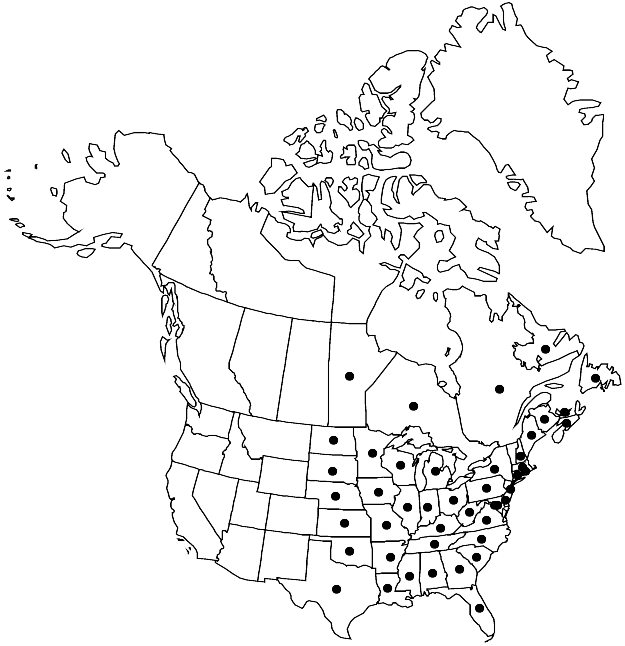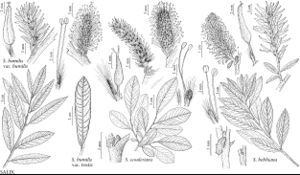Difference between revisions of "Salix humilis var. humilis"
FNA>Volume Importer |
imported>Volume Importer |
||
| (4 intermediate revisions by 2 users not shown) | |||
| Line 1: | Line 1: | ||
{{Treatment/ID | {{Treatment/ID | ||
|accepted_name=Salix humilis var. humilis | |accepted_name=Salix humilis var. humilis | ||
| − | |accepted_authority= | + | |accepted_authority= |
|publications= | |publications= | ||
|common_names=Prairie willow | |common_names=Prairie willow | ||
| + | |special_status={{Treatment/ID/Special_status | ||
| + | |code=F | ||
| + | |label=Illustrated | ||
| + | }}{{Treatment/ID/Special_status | ||
| + | |code=E | ||
| + | |label=Endemic | ||
| + | }} | ||
|basionyms= | |basionyms= | ||
|synonyms={{Treatment/ID/Synonym | |synonyms={{Treatment/ID/Synonym | ||
|name=Salix humilis var. hyporhysa | |name=Salix humilis var. hyporhysa | ||
|authority=Farwell | |authority=Farwell | ||
| + | |rank=variety | ||
}} {{Treatment/ID/Synonym | }} {{Treatment/ID/Synonym | ||
|name=Salix humilis var. keweenawensis | |name=Salix humilis var. keweenawensis | ||
|authority=(Andersson) B. L. Robinson & Fernald | |authority=(Andersson) B. L. Robinson & Fernald | ||
| + | |rank=variety | ||
}} {{Treatment/ID/Synonym | }} {{Treatment/ID/Synonym | ||
|name=Salix humilis var. rigidiuscula | |name=Salix humilis var. rigidiuscula | ||
| − | |authority= | + | |authority= |
| + | |rank=variety | ||
}} | }} | ||
|hierarchy=Salicaceae;Salix;Salix subg. Vetrix;Salix sect. Cinerella;Salix humilis;Salix humilis var. humilis | |hierarchy=Salicaceae;Salix;Salix subg. Vetrix;Salix sect. Cinerella;Salix humilis;Salix humilis var. humilis | ||
| Line 40: | Line 50: | ||
-->{{#Taxon: | -->{{#Taxon: | ||
name=Salix humilis var. humilis | name=Salix humilis var. humilis | ||
| − | + | |authority= | |
| − | |authority= | ||
|rank=variety | |rank=variety | ||
|parent rank=species | |parent rank=species | ||
| Line 54: | Line 63: | ||
|publication title= | |publication title= | ||
|publication year= | |publication year= | ||
| − | |special status= | + | |special status=Illustrated;Endemic |
| − | |source xml=https:// | + | |source xml=https://bitbucket.org/aafc-mbb/fna-data-curation/src/2e0870ddd59836b60bcf96646a41e87ea5a5943a/coarse_grained_fna_xml/V7/V7_137.xml |
|genus=Salix | |genus=Salix | ||
|subgenus=Salix subg. Vetrix | |subgenus=Salix subg. Vetrix | ||
Latest revision as of 22:31, 5 November 2020
Mid shrubs, 0.3–3 m. Stems usually erect, sometimes decumbent; branches tomentose to glabrescent, peeled wood smooth or striate, striae sometimes very dense, to 20 mm; branchlets red-brown or greenish brown. Leaves: stipules usually foliaceous (rarely rudimentary) on late ones; petiole (1.5–)3–7(–12) mm, velvety or pilose adaxially; largest medial blade narrowly oblong, narrowly elliptic, elliptic, oblanceolate, obovate, or broadly obovate, (20–)50–90(–135) × (7–)13–23(–35) mm, 2.3–4–7.5 times as long as wide, margins strongly revolute to flat, abaxial surface with hairs rarely also ferruginous, adaxial slightly or highly glossy, glabrous, pubescent, or pilose (hairs white, sometimes also ferruginous); proximal blade margins usually entire, sometimes serrulate. Catkins: staminate 14.5–34 × 7–19 mm, flowering branchlet 0 mm; pistillate 9–47(–55 in fruit) × 5.5–19 mm, flowering branchlet 0–4 mm; floral bract 1.2–2 mm. Staminate flowers: filaments glabrous. Pistillate flowers: ovary obclavate; stigmas 0.24–0.33–0.56 mm; ovules 6–12 per ovary. Capsules 7–12 mm. 2n = 38 and 76.
Phenology: Flowering (north) early Mar-early Jun, (south) late Jan-late Apr.
Habitat: Dry mixed woods and forests, Picea mariana-lichen woods, Picea glauca-Abies balsamea forests, wet to dry prairies, grassy balds, loess bluffs, sandy stream terraces, coastal barrens, Carex-Typha meadows, fine sand to rocky granitic, gneissic, limestone, and serpentine substrates
Elevation: 20-1600 m
Distribution

Man., N.B., Nfld. and Labr., N.S., Ont., P.E.I., Que., Ala., Ark., Conn., Del., D.C., Fla., Ga., Ill., Ind., Iowa, Kans., Ky., La., Maine, Md., Mass., Mich., Minn., Miss., Mo., Nebr., N.H., N.J., N.Y., N.C., N.Dak., Ohio, Okla., Pa., R.I., S.C., S.Dak., Tenn., Tex., Va., W.Va., Wis.
Discussion
See 79. Salix scouleriana and 82. S. atrocinerea for comparative descriptions.
Hybrids:
Variety humilis forms natural hybrids with Salix bebbiana, S. discolor, S. eriocephala, and S. planifolia. Hybrids with S. discolor or S. planifolia often are suggested by glabrous or glabrate leaves.
Selected References
None.
